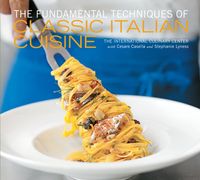Advertisement
Lamb
Appears in
As with other livestock, lamb (agnello) is divided into primal and subprimal cuts (see diagram of lamb that follows). In Italy, the names of the cuts vary by geographic area, and the cuts themselves may vary subtly as well. As with other proteins, the structure of the muscles and the percentage of fat and connective tissue contained therein (see “Harvesting and Processing”) determine which cooking techniques are best suited to each cut. Cuts with more connective tissue, such as shoulder and neck, benefit from wet-heat techniques such as braising and stewing, while leaner cuts with less connective tissue, such as rack and leg, work well with dry-heat techniques such as roasting, sautéing, and grilling.

